Use your supermarket money wisely – learn how to save money at the grocery store year-round with this list of over 40 grocery shopping tips!
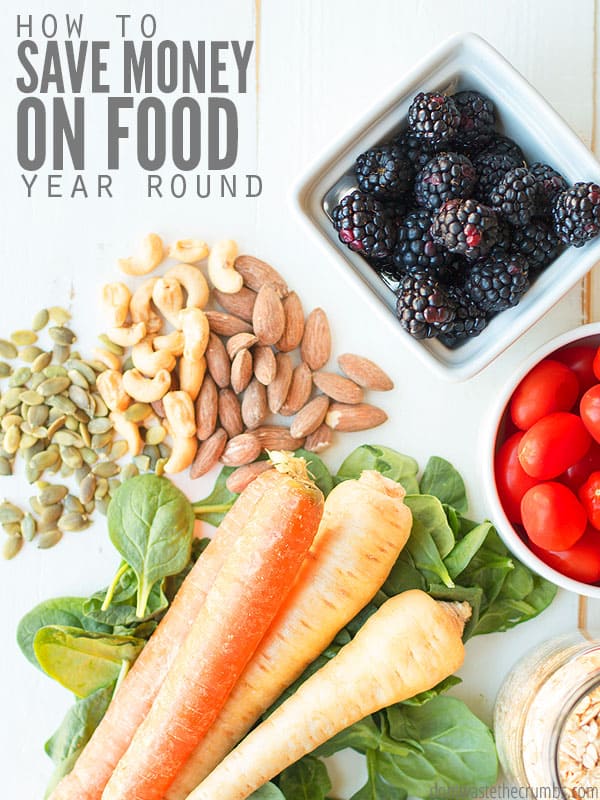
I like to think that with every new season comes new creative ways to save money on your grocery budget.
Over the years I’ve learned it’s not just about WHAT you buy, but also HOW and WHEN you buy it. In fact, adjusting how you think about grocery shopping makes the savings really start to add up – and this is EXACTLY what I teach in my course Grocery Budget Bootcamp.
Having the right mindset is vital to saving money on groceries, but it never hurts to have practical tips, too.
I’ve been collecting these tips over the years: the small things we’ve done to help our supermarket money go just a teeny bit further, and I’d like to share these 42 ways to save money on groceries with you today!
USE YOUR SUPERMARKET MONEY WISELY
Now, there are plenty of “broad scope” tips that I’ve shared before, like shopping in bulk, cooking in batches, shopping online, eating leftovers, and even making chicken stock out of kitchen scraps.
These are all great methods to save on food.
The various money saving tips on groceries that I’m sharing today are more specific. These are the types of things you’d find your best friend telling you, or more accurately, the things I’d tell you if we were sitting together at my kitchen table!
I’ve organized these ideas according to the season, but that doesn’t mean a money-saving tip for summer won’t work for winter. Be sure to read through all of them so you can start using the ones that would work best for you right now!
HOW TO SAVE MONEY AT THE GROCERY STORE IN THE SPRING
1. KNOW WHAT THE STORES CHARGE
Farmers markets open in early spring, but before you grab everything on your grocery shopping list there, make sure you know what the stores are charging, too.
Check your local circulars for discounts and sale items or use your price book to compare the unit price of items. Purchase from whichever has the best deal that week to save the most money.
Check out my Ultimate Guide to Shopping the Farmer’s Market on a Budget for more!
2. BUY ONE EXTRA POUND
The fun fruits of the year start making their appearance in spring, so take advantage of buying just one extra pound of fresh fruit each week over the spring and summer.
Preserve this fruit by freezing, canning, or dehydrating and if you’re faithful, you’ll be able to enjoy these fun flavors throughout the year!
3. CHOOSE FRESH OVER FROZEN DURING THE SEASON
Fresh foods almost always trump frozen food when it comes to taste, and they tend to be cheaper when they’re in season, too! Make a note on your list to browse the produce aisle first before the frozen aisle and see if those items are cheaper fresh.
4. MAKE THE FARMER’S MARKET YOUR FIRST STOP
Since the selection at farmer’s markets varies from week to week, it’s hard to predict what you’ll find. Make this your first stop on shopping day, so you can take advantage of what’s available. Make the regular grocery store your last stop to pick up what you couldn’t find, or to fill in for something that was out of your price range.
5. BUY THE WHOLE VEGETABLE
Carrots come with green tops and beets come with sturdy greens. Whenever possible, buy the whole entire vegetable so you can take advantage of those extra items! In fact, I’ve noticed that the entire vegetable – carrots WITH tops and beets WITH greens – often cost LESS than their topless counterparts!
Carrot tops can be used as a traditional herb in salads or in pesto, while beet greens can be used interchangeably with collards, mustard greens, and kale. There are many other ways to use food scraps HERE.
6. TRACK THE PRICE OF FRESH PRODUCE
Tracking the cost of fresh produce in your price book now can help you determine next year what to plant in the garden. Tomatoes and fresh herbs are easy to grow, and growing your own can really offset the monthly budget!
7. SHOP THE GARDEN
If you grow a garden, always shop there first. Substitute wherever possible, including fresh produce for canned.
8. BUY ONE OF THE “FUN” FOODS
Some items like blackberries and raspberries are significantly more expensive than others like strawberries and peaches – but that doesn’t mean you can’t have them! Make room in the budget for just one “fun” item and many more of the lesser cost items. You’ll be able to enjoy the fun foods of the season without sacrificing the budget.
9. DELAY SHOPPING GROCERIES
Eating what you already have in the house is a great way to save a LOT of supermarket money. Sometimes we get to the end of a week and think we are just supposed to go get groceries, but the pantry, fridge, and freezer still have lots of food.
Instead of rushing to the store, delay as long as you can and eat what you have. They may not be your favorite meals, but they are foods that you already paid for. Eat up your leftovers, avoid going out to dinner, and try eating a hodge-podge meal instead of the standard protein + veggie + starch.
Learn more about this in Grocery Budget Bootcamp! Enrollment is currently closed, but you can join my FREE 5-day Crush Inflation Challenge and start saving money on groceries tomorrow!
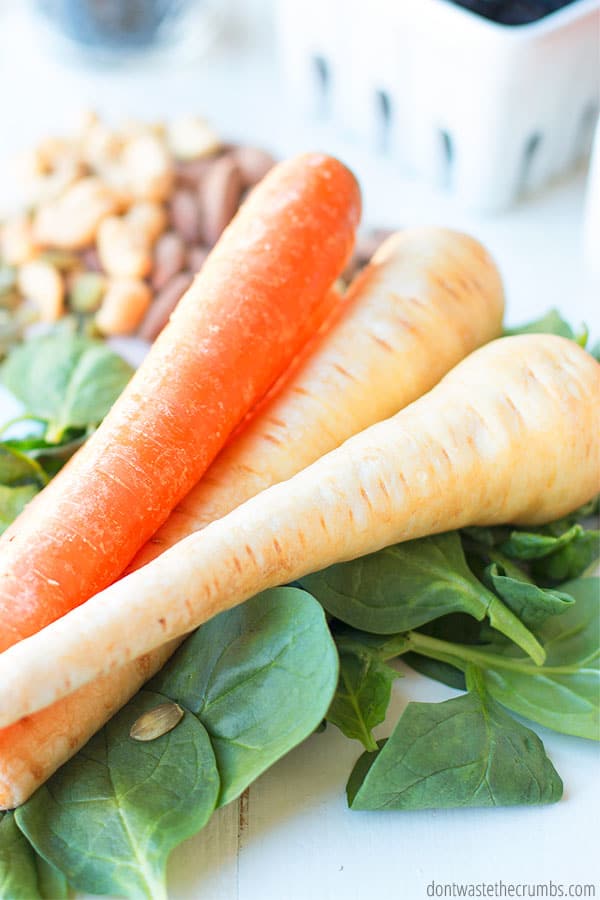
WAYS TO SAVE MONEY ON FOOD IN THE SUMMER
10. FRESH CORN VS. CANNED CORN VS. FROZEN CORN
Sweet corn is best in summer, and you can save by stocking up when ears are 33¢ or less. Cut the corn off the cob and freeze in 2 cup portions. Doing this not only saves supermarket money over frozen corn, but also it tastes much fresher!
11. PRESERVE YOUR OWN
So much produce is at its prime in summer that it would be wise to preserve what you can for later in the year. Consider canning or freezing tomatoes (including sauce if they’re past prime), green beans, and corn. Try to dehydrate your own herbs if possible, too.
12. WEIGH YOUR FRUITS AND VEGGIES
Always weigh your produce, even if it’s a per item price. Getting in the habit of this will help you identify whether you’re getting a good deal for something. Most of the time, heavy produce like melons and winter squash are more affordable at a per-item price than per pound. Aim for $2 or less per item, or 50¢ per pound for a great deal.
13. SUBSTITUTE FOR SEASONAL
Many people subscribe to CSA’s for the summer, me included. Take liberty in substituting whatever you find from your box with what’s in the meal plan. If you get beets one week, but they’re not on the menu, save the buttered peas for another night and make roasted beets instead!
If there’s not a local CSA in your area, try an online market like Misfits Market. If there’s not a local CSA in your area, try an online market like Misfits Market.
14. EAT MORE FRESH FOODS AND LESS MEAT
Fresh produce is the highlight of summer – it tastes better and is super affordable. Eat as much of it as you can right now and by default, you might find yourself eating less meat (which costs more). You can also stretch the meat that you DO eat – check out 10 Steps to Stretching Meat at Home.
15. COOK FROM SCRATCH AS OFTEN AS POSSIBLE
This is another great tip we go over in Grocery Budget Bootcamp. What staples can you try to cook from scratch? Salsa would be a delicious one for summer. This Easy Homemade Salsa, this Mango Salsa, or this Salsa Verde is great to start with.
Have you tried bread like 90-minute Man Bread yet? Even 2-Minute Mayo or Ranch Dressing you can make at home to save some supermarket money.
For even more ideas of foods to make at home, look at the Best Foods to Make from Scratch.
16. CLEAR OUT THE CUPBOARDS
Summer is the time to eat whatever items you have stored in the back of your fridge, freezer, and pantry. Summer harvest ends soon, and you’ll need the room to start putting up fresh foods for this winter.
17. SUBSTITUTE FOR WHAT’S ON SALE
What’s readily available varies from region to region, so substitute for whatever is on sale in YOUR area. That may mean apples instead of peaches or apricots instead of strawberries. Pay attention to the sales AND your meal plan and substitute to save!
18. END OF SEASON PRODUCE
Take advantage of the end of the summer by picking up a few extra pounds of fresh produce while they’re at the lowest price. Freeze, dehydrate, or can so you can enjoy the freshness into the coming winter months!
Related Post: How to Freeze Herbs
19. ENJOY APPLES AND SQUASH
Apples and squash make their debut at the end of summer, and there are so many different varieties to choose from that there’s something for everyone. Find a variety of apples (and squash) you like and eat to your hearts’ content while they’re in season. Try Apple Crumble Ice Cream or Butternut Squash Pasta Bake – yum!
20. GO U-PICKING
Speaking of apples and squash, pick your own for maximum savings. U-pick farms usually don’t spray much for pesticides, so while you might not be getting organic, they’ll be local, low in pesticides, delicious, and affordable!

HOW TO SAVE MONEY ON GROCERIES IN THE FALL
21. SQUASH VS. PUMPKIN
When you think about it, pumpkin IS a squash, so it shouldn’t come as much of a surprise that the two can be used interchangeably in most recipes. Switch out pumpkin for squash, or squash for pumpkin, depending on whatever is cheaper!
22. DIY PUMPKIN PUREE
Depending on the price of pumpkin puree, it may be cheaper to make it yourself. Or that may not be the case! Cost is compared by dividing the cost of a small baking pumpkin by 24 and the cost of a can by 15 (those numbers are about how many ounces of puree you’ll end up with). Choose whichever is cheaper!
Whether you end up with puree you’ve made yourself or bought on sale, try these Pumpkin Swirl Black Bean Brownies for a delicious fall treat!
23. DIY APPLE CIDER VINEGAR
Making your own apple cider vinegar out of apple peels and cores is a no brainer, and it saves a ton of supermarket money! Start collecting the peels and cores and start a batch when you have enough. Be diligent through the apple season and you might have enough ACV to last all year!
24. STOCK UP ON TURKEY AND HAM
Take advantage of sales in November and stock up on turkey and ham for the next few months. I’ve seen both types of meat as low as 49¢ per pound, and you can substitute shredded turkey for almost any recipe calling for shredded chicken.
25. STOCK UP ON BAKING SUPPLIES
Although prices for baking items don’t vary too much, baking RELATED items will be more affordable this month. Think baking cups, muffin tins, cookie sheets, bread loaf pans, parchment paper, etc. Make sure to compare your local grocery stores to online stores like Amazon for these items, too, and check for clearance items with holiday-themed packaging after the holidays. A Ziploc bag still holds food whether the box has pumpkins on it or not!
26. PRESERVE CRANBERRIES
Fresh cranberries are on store shelves for a very limited time, so take advantage while you can. Freeze them whole or consider dehydrating them for dried cranberries year-round.
27. PEARS VS. APPLES
Pears are in full season in December and can be used interchangeably in almost any recipe that contains apples. Although apples are inexpensive, too, they are usually affordable year-round, whereas pears are not, so take advantage! These Cheesecake Baked Apples are also delicious with pears.
28. BACON GREASE FOR COOKING
Always save bacon grease. It’s an additional cooking fat that is essentially free and would otherwise get thrown in the trash can!
Look at 13 Ways to Use Food Scraps for more tips on “free” food.
29. USE BUTTER WRAPPERS FOR GREASING PANS
Cross cooking spray off your list–permanently! Butter works just as well for greasing muffins tins and cookie sheets. I use the bits of butter at the end of a stick, or even just the wrapper. I fold up the empty wrappers and keep them in a small container at the door of the fridge.
30. MAKE YOUR OWN VEGGIE SIDE DISHES
If you’ve walked down the frozen veggie aisle recently, you’ve probably seen all sorts of veggie mixes with different sauces that you can just heat and eat. But it’s just as easy to cook your own! Pan-Roasted Broccoli only takes a few minutes, and tastes so good!
And if you’re willing to spend just a few minutes cutting potatoes, these Crispy Potato Wedges are even better than the store-bought bag of fries. Plus, a whole bag of potatoes costs far less and will give you more than one meal’s worth of sides.
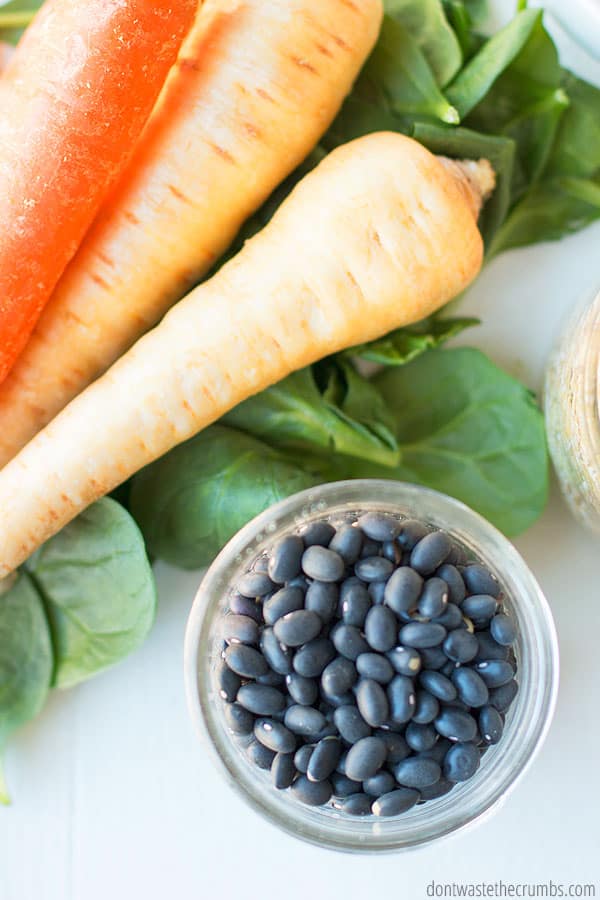
MONEY SAVING TIPS ON GROCERIES IN THE WINTER
31. REAL FOOD APPETIZERS
December usually means parties, and the best dish you can bring is an appetizer tray made with a variety of items you already have. Think of vegetable trays with a sour cream dip (using Homemade Dry Onion Mix), Potato Skins, or fruit dipped in chocolate. These are very simple, flexible, and affordable meals to take to any party!
32. MAXIMIZE CITRUS
When buying citrus specifically for juicing OR zesting, always take advantage of having the whole fruit and do both. Zest the fruit first, then juice it. Freeze the zest in a small freezer-safe container and measure the juice into 1 Tbsp servings in an ice cube tray. Remove cubes and store them in a freezer-safe bag. Here’s the full tutorial.
33. SAVE PARTIAL LEFTOVERS
When there are partial leftovers from cooking a meal, and you’re not quite sure what to do with them, choose one of the following options:
- Produce: add it to muffins or pancakes, a smoothie, or puree it and freeze it into cubes for later.
- Cheese: shred or dice (if it’s not already) and freeze for later.
- Meat: shred or dice and freeze to add to soups.
- Pasta: put it in the freezer for later.
34. SUBSTITUTE PRODUCE
Almost every winter squash tastes just like any other winter squash, so substitute for a different variety if one is available for less. Butternut, delicata, and acorn squash are very similar, so grab whichever one has the best price.
35. TRY A DIFFERENT BEAN
One of the best frugal proteins is beans, but don’t get stuck if you don’t have the right variety! Adzuki and pinto beans can be used instead of black beans, and navy or great Northern beans can be used in place of cannellini. As a bonus, you might find a bean to please even the pickiest of eaters.
Learn how to make your own beans from scratch HERE.
36. STRATEGICALLY BUY IN BULK
While almost anything CAN be bought in bulk, there are a few items that really save a lot per ounce when you make a bulk purchase. For example, buying yeast and coconut oil in bulk can save you a tremendous amount of money in the long run over smaller containers.
If you have extra money in the grocery budget, whether from last month or this month, I encourage you to find a good bulk source for one of the items you use regularly in your kitchen. Also, check out THIS post for 5 fail-proof ways to reduce grocery spending, so you have more left in your grocery budget to dedicate to a bulk purchase.
Wholesale clubs like Costco and Sam’s Club are great options for buying bulk foods. Be sure to weigh out the annual fee when making your decision to join. (Here’s why I think Costco is worth it.)
37. PURCHASE WHOLE CHICKENS, RATHER THAN CUT UP PIECES
You get a much cheaper price per pound when you buy a whole bird versus separate cuts. I use sharp kitchen shears to cut up the chicken, using the pieces for different types of meals (and the bones for chicken stock).
38. SAVE ALL THE BONES
Always save ALL the bones from every piece of chicken that comes into your kitchen. Whether it’s from a chicken you cooked or from a dinner plate – they can all be used in Homemade Stock.
Store them in a plastic freezer-safe bag and add them to the pot the next time you make stock. This not only re-uses what would ordinarily be thrown away but also allows you to make more stock with what you have.
39. MAKE YOUR OWN SPICE BLENDS
Spice blends can easily become the demise of your budget, but you can work around this by making them yourself. Buy the plain spices (cumin, garlic powder, etc.) locally for $1 and mix/match to create your own blends. Label appropriately, including how much you need to make a marinade or dressing. Keep the recipe handy (the spice cabinet itself is a good spot) so you can easily make more when needed.
40. INCLUDE “CATCH-ALL” MEALS
Several meals throughout the month can be designated as “catch-all” meals.
These types of meals are perfect for using up small portions of ingredients that you’re not quite sure what to do with. Soups, salads, and grilled sandwiches are ideal.
Take advantage of these meals and add any extra ingredients you might have on hand that need to get used up.
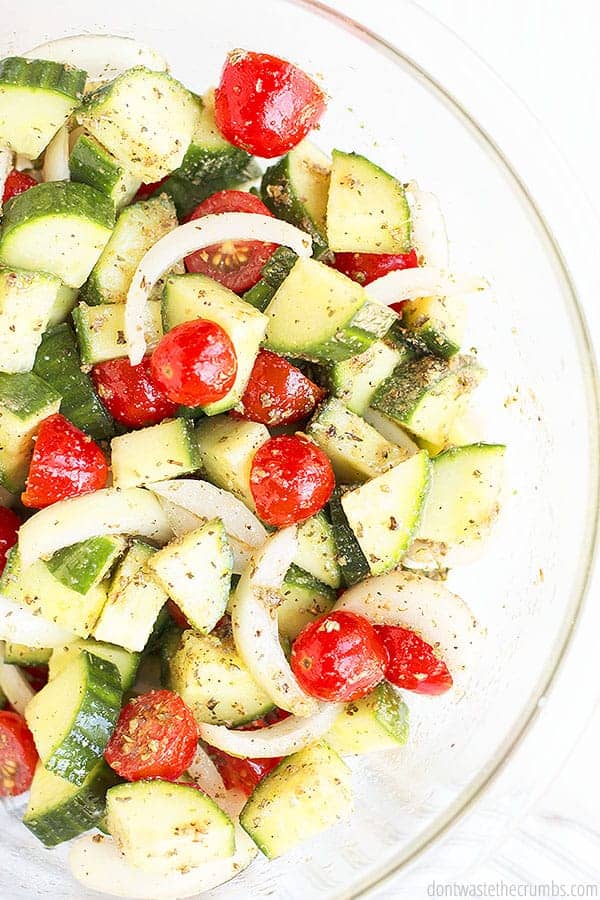
HOW TO SAVE MONEY ON FOOD YEAR-ROUND
41. MEAL PLAN
Make a meal plan so you can be sure you use up the food you already have and have meals that work WITH your calendar, not against it. If you need some help or a jump start, check out any of my meal plans HERE.
42. DON’T BE AFRAID TO TRY SOMETHING NEW
Tuna salad on biscuits? Peanut butter and jelly on an English muffin?
Although not a traditional meal, there’s nothing wrong with either one of these – especially if you’re already making biscuits or English muffins. What’s the point of adding more work? Double the recipe you’re already making, use it in place of something else, and save time and money.
MAKE THE MOST OF YOUR SUPERMARKET MONEY
Whether you’re a newbie in the real food world or a veteran of Grocery Budget Bootcamp, there is always more to learn when it comes to saving on groceries!
Are you ready to jump into saving on food right now? Sign up for the FREE Fight Inflation Workshop! Inside you’ll get access to three AMAZING sessions focused on saving money right NOW – despite the rising cost of food!
MORE SUPERMARKET MONEY TIPS
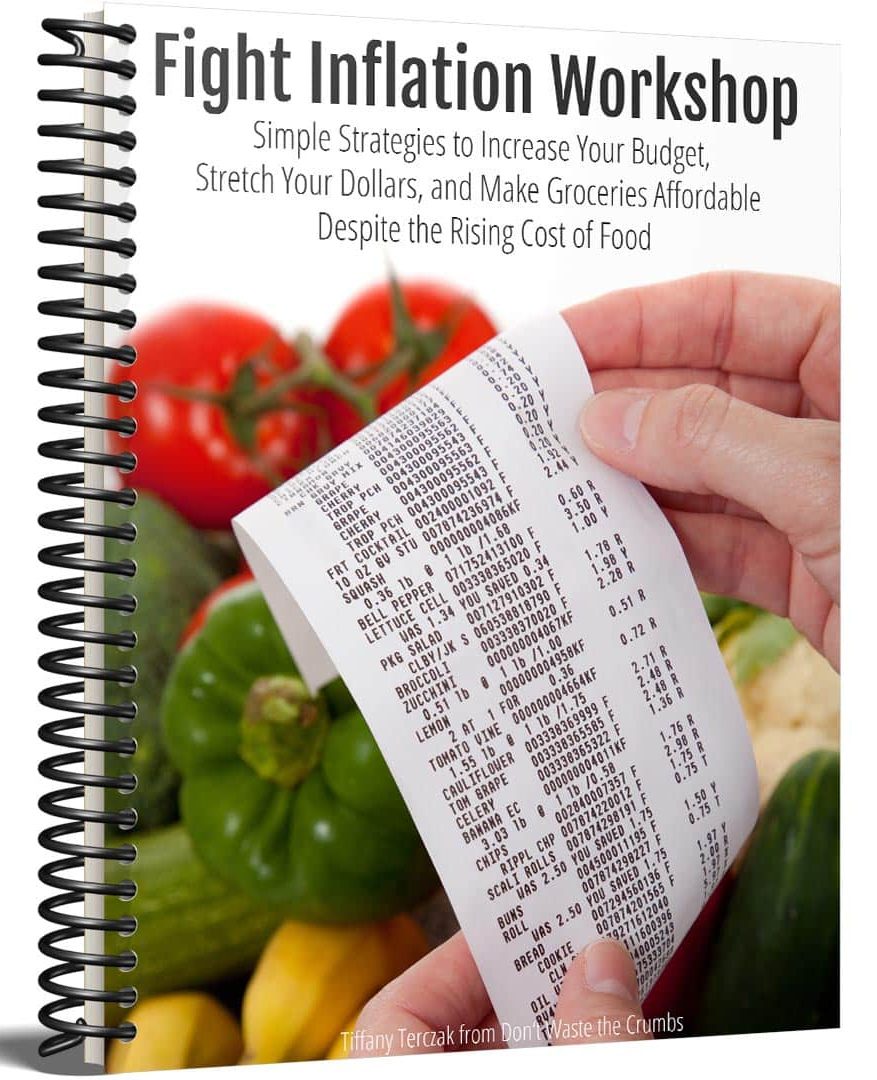

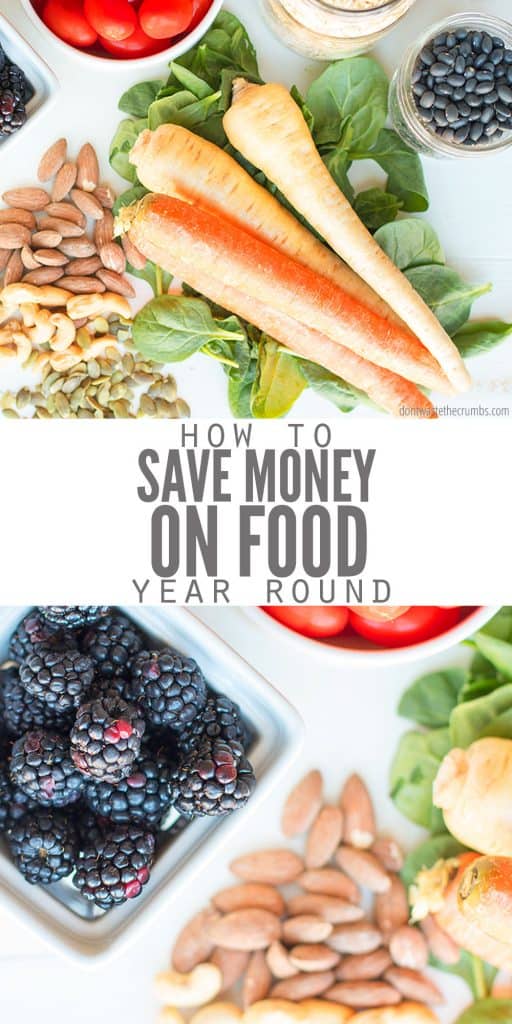

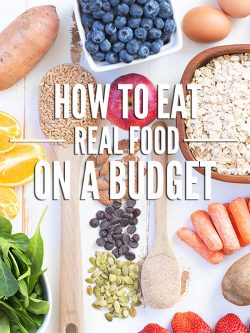

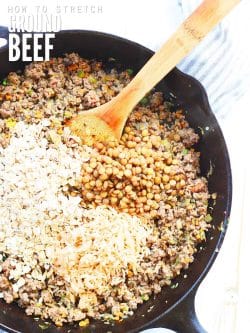

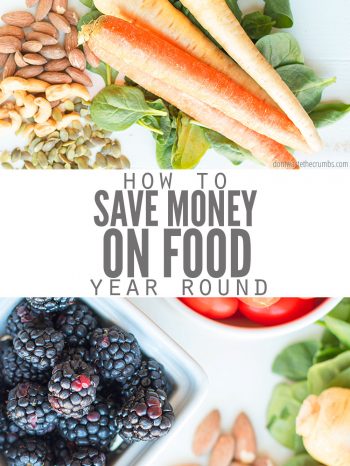
I have been making several of your recipes over the past few years, amongst others facial scrub/ wash, bentonite clay tooth paste, mayonnaise in mason jar. Thanks for all the inspiration and creative ideas over the years.
Eleanor,
You’re very welcome! And thank you!!!! 🙂
You’re so welcome, Eleanor! ♥
We save our veggie peelings , herb stems , and usable but past their prime veggies to make batches of veggie stock. We freeze it and whenever I need some , I just have to thaw it out. Can be used in soups, stews, risotto, etc.
We also save bread heels to make bread pudding. And meat stock from roasted meats can be saved and frozen for future use.
Strongly suggest only buying ORGANIC carrots with tops, as research has found the tops of non organic carrots have huge amounts of residual pesticides. Thank you for these great seasonal tips! !
Thank you for providing with useful tips on saving in groceries, vegetables and cooked good.
Vel